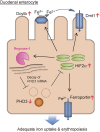Post-transcriptional regulation of immune responses by RNA binding proteins
- PMID: 29887569
- PMCID: PMC6085518
- DOI: 10.2183/pjab.94.017
Post-transcriptional regulation of immune responses by RNA binding proteins
Abstract
Cytokines are critical mediators of inflammation and host immune defense. Cytokine production is regulated at both transcriptional and post-transcriptional levels. Post-transcriptional damping of inflammatory mRNAs is mediated by a set of RNA binding proteins (RBPs) interacting with cis-elements, such as AU-rich elements (ARE) and stem-loop structures. Whereas ARE-binding proteins such as tristetraprolin and a stem-loop recognizing protein, Roquin, downregulate cytokine mRNA abundance by recruiting a CCR4-NOT deadenylase complex, another stem-loop RBP, Regnase-1, acts as an endoribonuclease, directly degrading target cytokine mRNAs. These RBPs control translation-active or -inactive mRNAs in distinct intracellular locations. The presence of various RBPs regulating mRNAs in distinct locations enables elaborate control of cytokines under inflammatory conditions. Dysregulation of cytokine mRNA decay leads to pathologies such as the development of autoimmune diseases or impaired activation of immune responses. Here we review current knowledge about the post-transcriptional regulation of immune responses by RBPs and the importance of their alteration during inflammatory pathology and autoimmunity.
Keywords: adaptive immunity; cytokines; inflammation; innate immunity; mRNA decay; translation.
Figures





References
-
- Moresco E.M., LaVine D., Beutler B. (2011) Toll-like receptors. Curr. Biol. 21, R488–R493. - PubMed
-
- Takeuchi O., Akira S. (2010) Pattern recognition receptors and inflammation. Cell 140, 805–820. - PubMed
-
- Medzhitov R., Horng T. (2009) Transcriptional control of the inflammatory response. Nat. Rev. Immunol. 9, 692–703. - PubMed
Publication types
MeSH terms
Substances
LinkOut - more resources
Full Text Sources
Other Literature Sources

